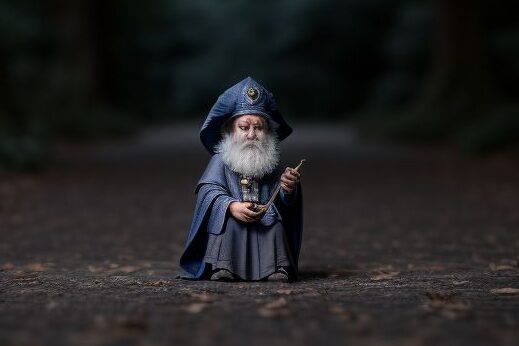
Religion, Hollywood, and an hysterical media are the main offenders for painting an unrealistic picture of what magick is and how it works. This is especially the case when it comes to daemonolatry and goetic magick which, suffering from a lack of information compared to RHP paradigms, is still relatively veiled. Even the way other practitioners discuss their experiences, albeit unintentionally, can be sensationalised.
Allow me to shed some light darkness on the matter…
What do demons look like?
A lot of demonolators perform their first goetic ritual, perhaps with a twinge of anxiety, expecting a demon to manifest to full physical appearance right in front of them. And when it almost always doesn’t happen, they might think that the ritual was a failure. They may have read online or elsewhere that ‘spirit X appeared to me as Y’. However, this is not always a literal statement. Every person comes to this art as a unique individual with his or her own set of strengths and weaknesses in various aspects of magick. Some are better at divination. Some are better at energy work. Very few see spirits, most can’t. Slightly more might hear spirits and, still, most can’t.

Most of the time I can’t see or hear anything, but rather subtle phenomena such as shifts in the room’s atmosphere, a spontaneous wave of goosebumps, or simply an slight intuition that the entity I am invoking has arrived.
Rarely, I get more obvious signals, which have included a two hour candle burning down in half an hour, a popping chunk of wax landing in my lap, and drawing the same single card from a deck of 72 tarot cards nine rituals in a row. Recently, I watched a spell candles burn down until it was completely done, after which I went out and came back to find that the wick had reignited and continued to do so for another hour and a half!
Very often, however, I get nothing at all… and that’s okay. The most important thing for improving your interaction with spirits is to assume that they are there. Put as much energy and focus on the ritual and assume beyond all doubt that your request has been heard, and then go out into the world with full and total trust that you have performed magick effectively. The testing arena for magick is the real world and your gauge of efficacy is the phenomena that happen after the ritual.

When a demon ‘appears’ to me, and I suspect this is the actual case with most practitioners, it is simply a spontaneous mental image in my mind’s eye rather than a full physical manifestation. This may very well be a projection influenced by images and descriptions of demons in the grimoires or online.
For example, while I was contemplating my first invocation to Prince Orobas, I found myself thinking a lot about horses and even had a sudden urge to drive down to a nearby property and feed the resident stallions a couple of carrots.
This preemptive projection, while useful for focus, does take some of the fun out of the magick. Not least of all because the pictures in the grimoires tend to portray the demons in a very ghastly light, such as multi-headed hybrids or as frail diseased humans.
Thus, I prefer as much as possible to cast aside preconceived expectations and instead allow space for the entity to appear to me as it pleases. Marquis Ronove, for example, portrayed in the Ars Goetia as a disproportionate naked man carrying a pitchfork, appeared to me as a forest sprite darting about the room.


How dare you assume my gender!
Okay, okay, identity politics aside. Goetic spirits are described in the Ars Goetia and similar grimoires as male. This is a fairly typical symptom of the patriarchical structure of the historical context in which it was first scribed. For demonolators, some spirits appear (or felt as) as masculine, some as feminine, some as androgynous, some show up differently for different spellcasters, some show up to the same magician as different genders at different times.

Given her history, it’s unsurprising that Astaroth almost invariably shows up to me and many others as female. That’s why many demonolators, myself included, refer to her as ‘Queen Astaroth’. Again, a lot of the gender variance depends on the expectations and projections of the spellcaster. However, it certainly speaks to the fact that every entity, including every human entity, contains within it both masculine and feminine qualities.
I did the ritual. Now what?
After the ritual, there are some important factors that will maximise your chances of success.
First, it is a complete waste of time if you don’t make any effort to achieve what you asked for. The ritual itself is for preparing your mind and your energy field to increase the probability of manifestation. The magick, however, continues long after this out in the real world. This isn’t Fantasia, where you chant an invocation and then sit at home waiting for something to happen all by itself.

If your goal is to get money, start working your ass off at your job or your business; if it’s to find love, go out and start socialising; if it’s to pass an exam, hit the books. Even if your goal is something seemingly passive like protection, make sure you’re taking everyday precautions and no unnecessary risks. The ‘sacrifice’ in magick is the energy you expend going after what you want. Ritual should be seen as fuel for an existing fire, not as the fire itself.
Romance and magick are kinda similar
Second, you need to pay attention to indicators of success, yet remain unattached to outcome. There is a paradox in magick that bears a striking parallel to the basic principles of romantic attraction.
Lusting for results – ‘spiritual neediness’, as I like to call it – will repel what it is you’re trying to achieve. Spiritual avoidance, on the other hand, is a blindness, either conscious or unconscious, to synchronistic windows of opportunity – an inability to recognise success and seize it before it slips away.

How to resolve this paradox? Like I said in the previous point, you must put in the work post-ritual to increase your likelihood of success, and act like you truly deserve it. At the same time, you should also have a sense of gratitude and appreciation for what you already have in your life, and that if the ritual doesn’t work out, it’s not the end of the world. To put it simply, you should prefer your ritual to work.
Drop the woo woo
Third, and finally, be realistic about the effects of your magick. A good sense of intuition and discernment is required to know the difference between when a demon is doing its work out in the real-world or whether it’s just a coincidence – situations or people showing up, or sudden bursts of inspiration, for example. In my opinion, this is actually a far more important skill to cultivate than any kind of extra-sensory perception, clairvoyance, or clairaudience. It is all to easy to attribute every tiny little event that happens to the work of a magick.

In a way, this isn’t so bad for reinforcing belief in your work, especially if the real-world event is congruent to your desired outcome. Suspended disbelief, as chaos magicians call it, is a very useful tool. You should believe it because you choose to, lest you over-inflate your power and act like you’ve just guzzled a couple of litres of ambrosia.
